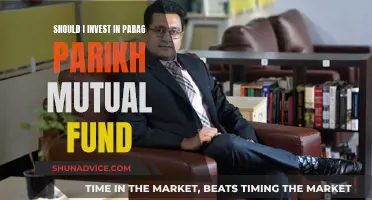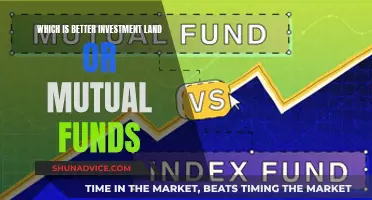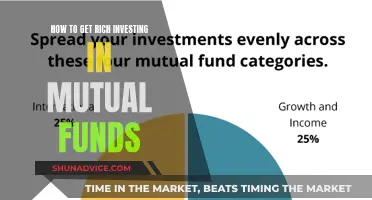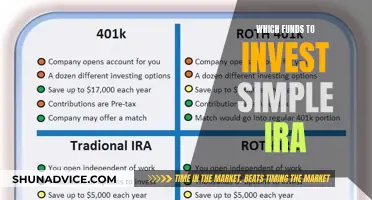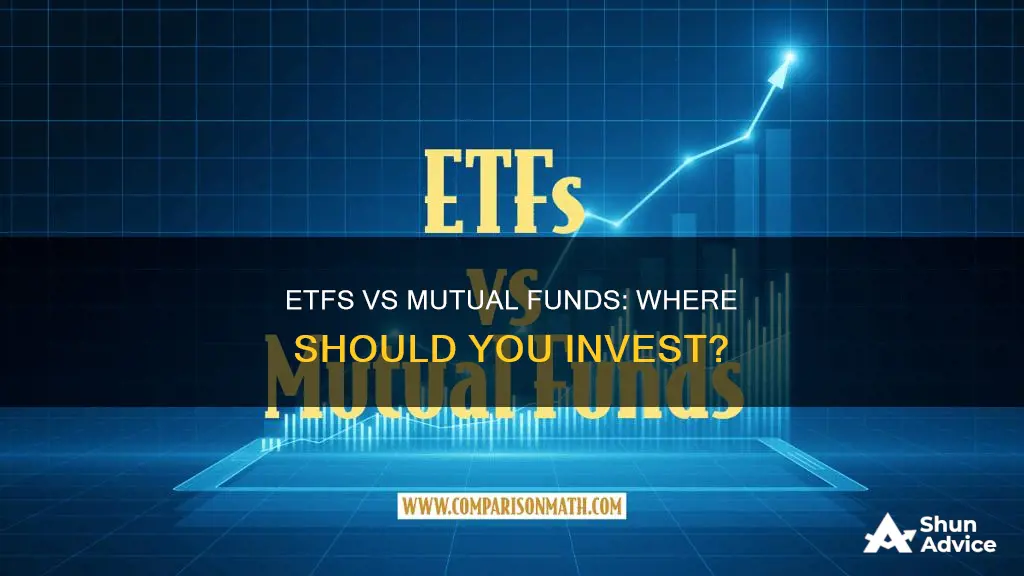
Exchange-traded funds (ETFs) and mutual funds are both popular investment vehicles that offer investors a way to diversify their portfolios. While they share some similarities, there are also key differences between the two that investors should be aware of when deciding where to allocate their capital. In this article, we will explore the pros and cons of investing in ETFs versus mutual funds and provide guidance on which option may be better suited for different types of investors.
| Characteristics | Values |
|---|---|
| Trading Mechanism | ETFs can be traded throughout the day like stocks.. Mutual funds can only be purchased at the end of each trading day. |
| Minimum Investment | ETFs usually have no minimum investment requirement. Mutual funds typically have a higher minimum investment requirement, ranging from $500 to $5,000. |
| Management | ETFs are usually passively managed and track a market index or sector sub-index. Mutual funds are usually actively managed, with fund managers making decisions about asset allocation. |
| Costs | ETFs generally have lower expense ratios than mutual funds due to their passive management style. Mutual funds tend to have higher costs associated with active management. |
| Tax Efficiency | ETFs are generally more tax-efficient due to their structure and lower turnover. Mutual funds may generate capital gains taxes when holdings are sold to meet redemptions. |
| Liquidity | ETFs offer greater liquidity as they can be traded during market hours. Mutual funds have limited liquidity as they can only be bought or sold at the end of the trading day. |

Active vs. passive ETFs
Exchange-traded funds (ETFs) are similar to mutual funds in that they are a collection of stocks or bonds, but they trade like stocks. ETFs can be actively or passively managed. Passively managed ETFs track a benchmark, such as a broad stock market index like the S&P 500, and are designed to replicate its performance. Actively managed ETFs, on the other hand, aim to outperform a benchmark through investment decisions by portfolio managers and analysts. Here is a detailed comparison of the two types of ETFs:
Passive ETFs
- Objective: The primary objective of passive ETFs is to replicate the performance of a specific benchmark index, allowing investors to achieve the market's performance over time.
- Management: Passive ETFs are designed to track an index and are not actively managed by a fund manager. They follow a buy-and-hold strategy and have limited transactions.
- Costs: Passive ETFs tend to have lower management fees and expense ratios compared to active ETFs. They are known for their cost-efficiency due to the absence of active management decisions.
- Performance: While passive ETFs aim to closely mirror the returns of the chosen benchmark, they do not aim to beat it. Their performance may be evaluated based on how closely they track the index rather than the annual return yielded.
- Risk: Passive ETFs offer diversification and are considered less risky than active ETFs. However, they are still subject to market risk, tracking risk, and liquidity risk.
- Suitability: Passive ETFs are suitable for investors seeking a long-term, buy-and-hold investment strategy. They are a good option for those who want to match the market's performance and do not require active management of their investments.
Active ETFs
- Objective: Active ETFs aim to outperform a benchmark and deliver higher returns for investors.
- Management: Actively managed ETFs involve a fund manager who actively selects the ETF's portfolio securities and allocation based on investment goals. They are not confined to tracking an index and have more flexibility in their investment decisions.
- Costs: Active ETFs tend to have higher management fees and expense ratios compared to passive ETFs due to the costs associated with active research, trading, and decision-making.
- Performance: While active ETFs have the potential to beat the market, there is also a risk of underperformance relative to the benchmark. Their performance is tied to the skills and expertise of the portfolio managers.
- Risk: Active ETFs may be more expensive to hold and carry the risk of underperformance or losses. They are subject to the same risks as passive ETFs but also have the additional risk of relying on the expertise of portfolio managers.
- Suitability: Active ETFs are suitable for investors who seek the potential for returns above the broad market and other indexes. They offer more flexibility and adaptability in their investment strategies.
Both active and passive ETFs have their advantages and disadvantages, and the choice between the two depends on your investment goals and style. Passive ETFs are generally suitable for long-term investors who want to mirror the market's performance, while active ETFs cater to those seeking higher returns and more flexibility. It is also possible to include both types of ETFs in your portfolio to achieve a balance between passive and active investment strategies.
Passive Index Funds: A Simple Guide to Getting Started
You may want to see also

Expense ratios
It is important to understand expense ratios because a high expense ratio can significantly impact your investment returns. A fund with a high expense ratio could cost you ten times, or even more, what you would pay for a fund with a low expense ratio. Over an investing career, choosing funds with low expense ratios could save you tens of thousands of dollars. As a general rule, any expense ratio higher than 1% is considered high and should be avoided.
Actively managed funds tend to have higher expense ratios than passively managed funds because they require a team of portfolio managers to actively select and trade investments. In contrast, passively managed funds simply aim to track the performance of a specific index, and so they are cheaper to run. According to Morningstar's 2020 US Fund Fee Study, the average expense ratio for passively managed funds was 0.12%, while for actively managed funds it was 0.62%.
When choosing between funds, it is important to consider not just the expense ratio but also other factors such as tax efficiency, how the fund fits into your overall investment strategy, and the amount of trading you plan to do. However, keeping expense ratios low is a good way to ensure your investments grow at a healthy rate.
Renaissance Medallion Fund: An Exclusive Investment Guide
You may want to see also

Liquidity
ETFs have higher liquidity than mutual funds, making them popular investment vehicles. The liquidity of an ETF is influenced by both primary and secondary markets. The primary market liquidity of an ETF is facilitated through the creation and redemption of shares by authorised participants (APs), who can exchange baskets of the ETF's underlying securities for new ETF shares from the fund issuer. This process helps adjust the supply of ETF shares to meet investor demand and maintain price stability.
The secondary market liquidity of an ETF refers to the ease with which investors can buy or sell ETF shares on exchanges, similar to individual stocks. This liquidity is determined by metrics such as trading volume, market depth, and the bid-ask spread. High trading volumes and narrow bid-ask spreads indicate good liquidity.
While trading volume can be an indicator of liquidity, it is not the sole factor. ETFs with lower trading volumes can still have good liquidity due to the creation and redemption mechanisms. Additionally, the liquidity of the underlying assets held by an ETF also impacts its overall liquidity. ETFs that invest in large-cap, domestically traded companies tend to be more liquid, while those investing in less liquid securities, such as real estate or emerging market assets, may have lower liquidity.
Understanding the liquidity of an ETF is crucial for investors as it impacts trading costs and helps determine how closely the ETF's price tracks its underlying assets. It also ensures that investors can buy or sell shares at prices that reflect the value of those underlying assets.
Mutual Fund Investment: Current Smart Choices
You may want to see also

Market or sector risk
- Diversification Benefits: ETFs offer diversification benefits by providing exposure to a wide range of stocks, bonds, and other assets. This diversification helps to reduce the impact of market or sector-specific risks. However, it's important to note that some ETFs may lack diversification, especially those focused on specific sectors or industries.
- Specific Sector or Industry Risk: ETFs that focus on specific sectors or industries, such as real estate or energy, are more vulnerable to market or sector risk. For example, a real estate ETF's performance depends on the overall health of the real estate industry. If that industry experiences a downturn, the ETF is likely to be negatively affected.
- Geographic Risk: Some ETFs invest in companies or assets from specific geographic regions or countries. These ETFs carry the risk of economic, political, or social instability in those regions, which can impact the performance of the ETF.
- Risk Mitigation: To mitigate market or sector risk, investors can diversify their portfolios across various sectors and asset classes. By investing in a mix of broad-market and multi-sector ETFs, you can reduce the impact of a downturn in any particular sector or industry.
- Performance and Volatility: The potential for large swings in ETF performance depends on the scope of the fund. Broad market index ETFs, such as those tracking the S&P 500, are generally less volatile than ETFs focused on specific sectors or industries.
- Risk and Returns: While diversification helps manage risk, it's important to remember that it may also dilute returns. ETFs that focus on specific sectors or industries may offer higher return potential but carry greater risk.
- Active vs. Passive ETFs: Passive ETFs aim to replicate the performance of a broad market index and are generally less volatile. On the other hand, actively managed ETFs have portfolio managers making decisions about which securities to include, and they may carry higher fees.
Series C Funding: Strategies for Successful Investment
You may want to see also

Currency risk
For example, let's say you invest in US equities through an ETF. If the US dollar weakens against your local currency, the value of your investment will decrease when converted back to your local currency, even if the US stock market remains unchanged. On the other hand, if the US dollar strengthens against your local currency, the value of your investment will increase.
Additionally, the time horizon of your investment also plays a role in managing currency risk. Long-term investors may have less to worry about, as exchange rate fluctuations tend to have a smaller impact on equity returns over longer periods. However, if you need to sell your investments in the short run, your vulnerability to exchange rate volatility increases.
It's worth noting that currency ETFs themselves are subject to currency risk. These funds allow investors to gain exposure to foreign currencies and benefit from changes in exchange rates. However, currency moves can be unpredictable, and currency gyrations can adversely affect portfolio returns. Therefore, it's crucial to carefully consider the risks associated with currency investing before making any investment decisions.
Vanguard Prime Money Market Fund: A Smart Investment Move
You may want to see also
Frequently asked questions
When you buy a stock, you're buying shares of a single company. An ETF, on the other hand, holds a collection of several stocks, bonds, commodities, or a combination of these. Each share of an ETF that you purchase gives you a slice of all the underlying assets. This makes it easier to diversify your portfolio.
In many cases, ETFs are considered safer than stocks because they provide inherent diversification. If a company whose stock you own performs poorly, your portfolio will take a hit. However, if one or two stocks in an ETF perform poorly, the other holdings in the ETF can offset those losses.
Yes, ETFs are a great option for beginners as well as experienced investors. They are relatively inexpensive, widely available, and tend to be less risky than investing in individual stocks.
ETFs offer several benefits, including diversification, transparency, and low costs. However, there are also some potential drawbacks, such as market or sector risk, currency risk, liquidity risk, and tracking errors.
You can buy and sell units in an ETF through a stockbroker, similar to buying and selling shares. You can also buy and sell units directly with the ETF provider, usually at a price reflecting the net asset value (NAV) of the units.


